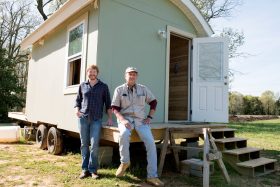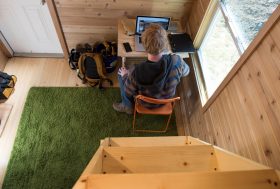Senior Dustin Pfaehler’s legacy at Elon is the research he’s conducted on a hand-built tiny house found at Loy Farm, where faculty and administrators hope to launch a living-learning community.

The small house atop a flatbed trailer at the university’s Loy Farm originated from a joke. In the fall of 2014, shortly after attending a Sierra Club-sponsored campus screening of the film “Tiny: The Story of Living Small,” Dustin Pfaehler quipped to an academic mentor in the Department of Environmental Studies about the benefit of building his own tiny house to save rent money.
Pfaehler laughed at the idea. His adviser and mentor, Michael Strickland, didn’t. “He actually thought it was great,” Pfaehler recalls.
More than a year later and after extensive research into the history of tiny houses, what you see on the farm is a great example of sustainable living, and a potential model for a future living-learning community comprised of similar small houses. The house is Pfaehler’s independent research project—the last credits he’ll earn before his graduation this spring—and one he built himself. Upon entering the 120-square-foot house is a kitchenette with a working sink, a toaster oven and a small refrigerator. A shower and toilet area is off the kitchen. To the immediate left is a hand-built table and folding chair where Pfaehler often works on his laptop. Right behind him is a wooden ladder that takes him to a lofted mattress atop the kitchenette and shower.
The house connects to the power grid via a nearby pavilion and storage barn. Water is pumped in from a well on the farm and a bin traps runoff from the kitchen and the shower. A propane tank helps heat water. The toilet requires use of disposable waste bags since it’s not hooked up to a sewer line or a septic system, though Pfaehler only uses it in case of emergencies since he maintains a nearby apartment and spends much of his time on main campus.

But interest alone isn’t enough. Faculty and staff are already giving thought to what types of students might thrive full-time in a small house, and Pfaehler is contributing to those discussions with his data collection. Since finishing the house during Winter Term, he has spent long days on Loy Farm, tracking water and electricity output and journaling his reflections on his sparse quarters. “It’s very cozy, surprisingly,” Pfaehler says of his research. “Being out here alone is kind of neat. It’s quiet, so when there’s noise, I’m definitely startled.”
Pfaehler may have been the ideal Elon student to attempt a small house research project. When not helping his parents with the family’s South Carolina carpentry and interior millwork business, he’d spend much of his time outdoors, kayaking or backpacking when the opportunity presented itself. He initially came to Elon for environmental engineering but later decided on environmental studies. In line with his commitment to sustainability, Pfaehler built the house with as much recycled material as possible. He started the project last summer on a flatbed trailer acquired near home. In his free time at the family warehouse, he’d use power equipment to erect a frame, roof and walls, almost all of which he obtained as surplus from a track builder who conducted business with his father.
 At the end of last October, a family friend transported the house and trailer to Elon. Pfaehler completed the interior work over the fall semester and into Winter Term. Other small houses are now in the initial stages of construction on Loy Farm under the supervision of Robert Charest, an associate professor of environmental studies who teaches courses on sustainable architecture and design. Student interest in small houses coincides with national attention on the trend. Stories abound of homeowners choosing to downsize for both ecological and economical reasons. HGTV has even gotten in on the trend with shows such as “Tiny House Hunters” and “Tiny House, Big Living.”
At the end of last October, a family friend transported the house and trailer to Elon. Pfaehler completed the interior work over the fall semester and into Winter Term. Other small houses are now in the initial stages of construction on Loy Farm under the supervision of Robert Charest, an associate professor of environmental studies who teaches courses on sustainable architecture and design. Student interest in small houses coincides with national attention on the trend. Stories abound of homeowners choosing to downsize for both ecological and economical reasons. HGTV has even gotten in on the trend with shows such as “Tiny House Hunters” and “Tiny House, Big Living.”
Popularity is strongest among young people and those without children in the home. There are a number of reasons supporters have cited in popular media for why they’ve downsized to homes that, in some instances, are less than 100 square feet. It’s economical. It fosters creativity. It’s better for the planet. Pfaehler says that once he leaves Elon, he’ll either take the house with him to a new town for a job in environmental fieldwork, or possibly relocate it to undeveloped family land in the mountains of western North Carolina. Those who have been part of Pfaehler’s journey at Elon are just as eager to see where life takes him—with or without a trailer in tow.
“There’s something exciting about figuring out how to be efficient and small,” Strickland says of Pfaehler’s house. “You can graduate from college and own your own home for less money than people spend on cars. There’s a freedom in that, being able to just pack up and go.”


